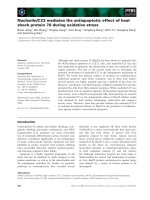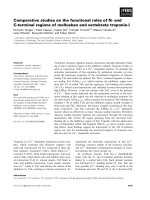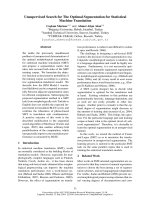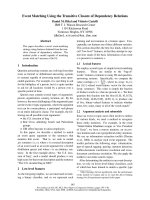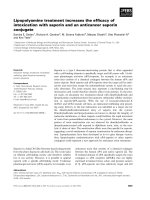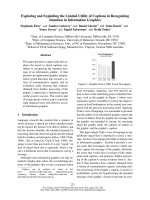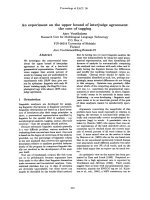báo cáo khoa học:" Cephalometric norms for the Saudi children living in the western region of Saudi Arabia: a research report" potx
Bạn đang xem bản rút gọn của tài liệu. Xem và tải ngay bản đầy đủ của tài liệu tại đây (237.73 KB, 6 trang )
BioMed Central
Page 1 of 6
(page number not for citation purposes)
Head & Face Medicine
Open Access
Research
Cephalometric norms for the Saudi children living in the western
region of Saudi Arabia: a research report
Ali H Hassan*
Address: P.O. Box 80209, Jeddah 21589, Preventive Dental Sciences Department, Faculty of Dentistry, King Abdulaziz University, Jeddah, Saudi
Arabia
Email: Ali H Hassan* -
* Corresponding author
Abstract
Background: Previous studies have established specific cephalometric norms for children with
different ethnic backgrounds, showing different facial features for each group. Up till now, there is
a paucity of information about the cephalometric features of Saudi children living in the western
region of Saudi Arabia, who have distinct social and climatic characteristics. The aim of the present
study was to establish cephalometric norms for children living in the western region of Saudi
Arabia.
Methods: A total of 62 lateral cephalometric radiographs of Saudis (33 females and 29 males; aged
9–12 years) having good facial proportions and Class I dental occlusion, were traced and analyzed.
Using the t-test, the mean value, standard deviation and the range of 20 angular and linear variables
were calculated and compared to norms of adult Saudis living in the Western region of Saudi Arabia
using the t-test. Male and female groups were also compared using the t- test.
Results: Saudi children tend to have a significantly shorter and lower face height, a larger angle of
convexity, and more proclined and protruded incisors when compared with adult Saudis (P < 0.05).
There were no statistically significant differences between male and female groups.
Conclusion: Saudi children have distinct cephalometric features, which should be used as a
reference in the orthodontic treatment of young Saudi patients.
Background
In orthodontic diagnosis and treatment planning, a
cephalometric radiograph is an essential tool to relate
patients with different malocclusions to their associated
norms. Previous studies have established cephalometric
norms for children in different countries who are descend-
ants of special racial backgrounds [1-9]. Saudis were
found to have distinct craniofacial features as compared
with European-Americans [6-9]. Unfortunately, all the
previously mentioned studies were performed in the cen-
tral region of Saudi Arabia and there was only one study
conducted in the western region, in which cephalometric
norms were established for Saudi adults and then repre-
sented graphically on a wiggle to count for the variability
of the readings among the Saudi population [9]. Results
showed that Saudis, in general, have an increased ANB
angle and bimaxillary protrusion when compared with
European-American norms. It was concluded that the
established norms should be used as a reference in the
orthodontic treatment of Saudi adults. In addition,
Published: 24 August 2005
Head & Face Medicine 2005, 1:5 doi:10.1186/1746-160X-1-5
Received: 30 April 2005
Accepted: 24 August 2005
This article is available from: />© 2005 Hassan; licensee BioMed Central Ltd.
This is an Open Access article distributed under the terms of the Creative Commons Attribution License ( />),
which permits unrestricted use, distribution, and reproduction in any medium, provided the original work is properly cited.
Head & Face Medicine 2005, 1:5 />Page 2 of 6
(page number not for citation purposes)
cephalometric norms should be presented on a polygon
to count for the high variability that was observed in the
Saudis because of their multiethnicity. A wiggle, as
described by Vorhies and Adams [10], is a graph in which
all average norms are plotted on a central vertical line. The
maximum and the minimum readings of each norm are
plotted on either side of the central line in a way that all
the Class II readings are placed on the left side and the
Class III readings are placed on the right side of the central
line [10]. Unlike Vorhies and Admas [5], Hassan [9] used
one standard deviation instead of the maximum and min-
imum readings of each reading.
The objectives of the present study were to establish
norms for Saudi children living in the western region of
Saudi Arabia and to present them graphically in the form
of a polygon to count for any possible variation due to
age, gender and multiracial background of the represent-
ing sample.
Methods
The present study was approved by the Ethical Committee
of the Faculty of Dentistry, King Abdulaziz University
(KAAU), in which a total of 62 lateral cephalometric radi-
ographs of Saudi children (33 females and 29 males; aged
9–12 years) having acceptable profiles with competent
lips, Class I dental and skeletal relationships, minimum
overbite and overjet, minimum or no crowding, and no
previous orthodontic treatment were selected to be
included in the study group. The selected subjects were
Saudis (by nationality) born and living in the western
region of Saudi Arabia and of Arab descent. They were
selected through the public health program that was con-
ducted by the Department of Preventive Dental Sciences
Cephalometric reference pointsFigure 1
Cephalometric reference points. Different reference points used in the present study and their abbreviations.
Pog (Pogonion)
Gn (Gnathion)
Head & Face Medicine 2005, 1:5 />Page 3 of 6
(page number not for citation purposes)
at KAAU, in which primary and intermediate public
schools were visited for caries assessment and patient oral
health education.
The radiographs were traced and analyzed manually by a
single examiner. Twenty angular and linear measurements
were calculated (Table 1 and figure. 1). The mean value,
standard deviation and range of each variable was calcu-
lated and compared with the norms established for Saudi
adults living in the western region of Saudi Arabia [4]. In
addition, measurements were compared between male
and female children. An independent sample t-test was
used in the comparison between children and adults and
as well as between male and female groups. To assess trac-
ing errors, a second tracing was prepared for every 10 trac-
ings. The mean error in linear measurements was ± 0.35
mm. The mean error in angular measurements was ±
0.92°. A set of cephalometric values was established for
Saudi children. The resulting data (means and standard
deviation) were represented diagrammatically in the form
of a polygon (Wiggle) (Figure 2) using the mean value
plus or minus one standard deviation.
Results
Table 2 and figure 2 show the mean and standard devia-
tion of the 20 angular and linear measurements selected,
which represent the norms established in the present
study. As compared with adult Saudis, children have a sig-
nificantly increased angle of convexity which indicates
more convex profiles in the Saudi children (P < 0.05). In
addition, the lower face height was significantly shorter in
the children's group (P < 0.05). The ANB angle was insig-
nificantly increased in the children's group (P < 0.05).
Dentally, upper and lower incisors were significantly
more proclined and more protruded in the children's
group (P < 0.05). The other readings were generally
similar between Saudi children and adults. In addition
there were no statistically significant differences between
Saudi males and females (P < 0.05) (Table 3).
Graphical presentation of cephalometric norms for Saudi childrenFigure 2
Graphical presentation of cephalometric norms for Saudi children. A graph (Wiggle) in which cephalometric norms
for Saudi children (mean age: 12.2 years) are plotted on a central vertical line. The readings of plus or minus one standard devi-
ation of each norm are plotted on either side of the central line in a way that all the Class II readings were placed on the left
side and the Class III readings were placed on the right side of the central line.
0.0 0.0 0.0 0.0 0.0 0.0 0.0 0.0 0.0 0 .0 0.0 0.0 0.0 0.0 0.0 0.00.0 0.0 0.0 0.0 0.0 0.0 0.0 0.0 0.0 0 .0 0.0 0.0 0.0 0.0 0.0 0.00.0 0.0 0.0 0.0 0.0 0.0 0.0 0.0 0.0 0.0 0.0 0.0 0.0 0.086.6 79.6 75.4 4.1 27.3 37.3 71.1 105.4 26.3 6.1 120.8 94.7 28.8 6.8 55.0 7.7
90.0
76.2
78.9
2.5
23.4
42.2
74.9
113.7
33.9
3.2
103.2
110.3
34.9
9.3
52.1
11.9
83.1
83.0
71.9
5.8
31.3
32.3
67.3
97.1
18.7
9.1
131.4
86.2
22.7
4.2
58.0
3.5
-15 .0
-10 .0
-5.0
0.0
5.0
10.0
15.0
NPG_HF
SNA
SNB
ANB
MP - F H P
MP _ S N
Y_ AXIS
U1_ SN
U1_NAZ
U1_NAM
U1_L1
L1_MP
L1_NBZ
L1_NBM
L_ F C _ HT
NA_APG
Head & Face Medicine 2005, 1:5 />Page 4 of 6
(page number not for citation purposes)
Table 1: Different linear and angular measurements used
NPog-FH Intersection between NPog plane and Frankfort horizontal plane
NPog-FH Intersection between NPog plane and Frankfort plane
SNA Maxillary apical base relationship to anterior cranial base
SNB Mandibular apical base relationship to anterior cranial base
ANB Apical base relationship
NA-APog Angle of convexity
MP-FH Inclination of mandibular plane to FH
MP-SN Inclination of mandibular plane angle to anterior cranial base
OC-PL-SN Inclination of occlusal plane to anterior cranial base
Y-axis Angle made between SN and NGn line
L-FC. Ht Lower face height (Anterior nasal spine-Menton)
U1-SN Inclination of maxillary incisors to anterior cranial base
U1-NAz Inclination of maxillary incisors to NA
U1-NAmm Protrusion of maxillary incisors to NA
U1-L1 Inclination of maxillary incisors to mandibular incisors
L1-MP Inclination of mandibular incisors to mandibular plane
L1-NBz Inclination of mandibular incisors to NB
L1-NBmm Protrusion of maxillary incisors to NB
L1-APogz Inclination of mandibular incisors to APog plane
L1-APogmm Protrusion of mandibular incisors to APog plane
Table 2: Cephalometric Standards for Saudi children
Cephalometric
Variables
Saudis (Children) n = 62 Saudis (Adults) n = 68 t p
Mean SD Mean SD
NPog_FH 86.6 3.2 86.9 3.64 .054 0.957
NPog- SN 76.4 3.7 78.7 4.61 2.887 0.005*
SNA 79.6 5.4 80.8 4.06 .816 0.416
SNB 75.5 3.6 77.5 4.48 1.984 0.050
ANB 4.1 1.7 3.3 1.52 1.717 0.089
NA-APog 7.7 4.5 5.01 3.05 4.238 0.000*
MP/FH 27.3 4 28.5 4.79 1.103 0.272
MP/SN 37.2 5 35.9 5.96 1.940 0.055
Occl. Pl -SN 20.4 4.8 18.7681 6.21 .257 0.79
Y_AXIS 71.1 3.6 69.6 4.19 .460 0.647
L-F.HT 54.7% 1.198 56.0% 2.7 2.503 0.014*
U1_SN 105.5 5.6 106.8 8.07 2.922 0.004*
U1_NAZ 26.3 8.3 27.3 7.55 2.718 0.008*
U1_NAMM 6 1.8 6.8 2.92 4.491 0.000*
U1_L1 120.8 7.4 120.6 11.97 .277 0.782
L1_MP 94.7 6 93.9 7.7 2.276 0.025*
L1_NBZ 28.8 5.8 29.3 6.89 1.219 0.225
L1_NBMM 6.8 2.3 7.5 2.63 2.975 0.004*
L1_APogZ 26.5 5 27.23 6.07 0.564 0.574
L1_APogMM 4.5 1.97 4.89 2.89 2.064 0.042*
* P < 0.05
Head & Face Medicine 2005, 1:5 />Page 5 of 6
(page number not for citation purposes)
Discussion
Considering the ethnic background of patients in setting
treatment objectives is an important requirement for suc-
cessful orthodontic treatment. This can be achieved by
establishing cephalometric and facial norms for the differ-
ent racial groups. Unfortunately, there are no
cephalometric norms for Saudi children living in the west-
ern region of Saudi Arabia. This study is considered as the
first trial to establish norms for Saudi children living in
that region.
The Saudi race in the western region of Saudi Arabia is
unique in composition, which is multiracial in nature and
has been established through interbreeding among the
different communities who migrated there to be close to
the Holy mosques of the Islamic world [9]. The sample
used in the present study was carefully selected to include
Arab-Saudis born and living in the western region of the
Kingdom of Saudi Arabia. Hassan (2006) found that
Saudi adults have an increased facial convexity, a more
convex profile, a steeper mandibular plane, more pro-
truded upper and lower incisors and shorter lower face
height as compared with European-Americans [9].
Results of the present study have shown that Saudi chil-
dren have statistically different skeletal and dental fea-
tures than Saudi adults living in the western region of
Saudi Arabia. These differences were noticed in the facial
plane angle, angle of convexity, lower face height and the
inclination of incisors. Most of the differences go with the
general growth pattern of the human face, in which chins
are more retrognathic and profiles are more convex during
childhood and tend to straighten by age [11] (Table 2). In
addition, lower face height tends to increase with age dur-
ing the transition from childhood to adulthood which
could be attributed to the cephalo-caudal gradient of
growth of the facial bones [12]. Dentally incisors tend to
protrude and procline with age in the Saudis, which could
be attributed to environmental factors such as the clini-
cally observed high incidence of mouth breathing and
tongue thrusting habits among Saudi youngsters.
Although the ANB angle is insignificantly increased in
children as compared with adults, it is still considered as
an important result to emphasize, for proper orthodontic
diagnosis. An ANB angle of four degrees and an angle of
convexity of seven degrees should be considered normal
in children. In addition, an ANB angle of two degrees,
which is considered normal in adults, should be investi-
gated more in children to exclude the tendency for Skele-
tal Class III relationship.
Table 3: Comparison of cephalometric measurements of the Saudi male and female children using t-test
Cephalometric
Variable
Male (n = 29) Female (n= 33) P
Mean SD Mean SD
NPog_FH 87.9 3.3 86.1 2.96 .64
NPog- SN 75.2 4.4 76.9 3.2 .42
SNA 74 5.1 77.8 4.98 .06
SNB 74.75 4.3 76.2 3.1 .38
ANB 3.8 1.7 3.9 1.8 .105
NA-APog 7 4.8 7.3 4.5 .058
MP/FH 25.4 4.5 26 3.8 .12
MP/SN 38 5.7 35 4.4 .418
Occ.P -SN 21.2 5.9 20 4.14 .174
Y_AXIS 70.4 4.1 69.5 3.4 .224
U1_SN 104.4 5.96 105.3 5.4 .095
U1_NAZ 28.6 8.2 25.4 5.5 .155
U1_NAMM 5.96 1.6 5.9 1.9 .062
U1_L1 122.2 7.6 120.95 7.4 .074
L1_MP 95.97 5.9 98.4 6 .224
L1_NBZ 28.7 5.3 29.3 6 .072
L1_NBMM 7.6 2.3 6.8 2.4 .471
L1_APogZ 25.5 4.5 26.96 5.3 .188
L1_APogMM 4.875 1.86 4.3 2 .496
Pg to NBMM 0.5 1.6 1.5 1.6 1.26
* P < 0.05
Publish with Bio Med Central and every
scientist can read your work free of charge
"BioMed Central will be the most significant development for
disseminating the results of biomedical research in our lifetime."
Sir Paul Nurse, Cancer Research UK
Your research papers will be:
available free of charge to the entire biomedical community
peer reviewed and published immediately upon acceptance
cited in PubMed and archived on PubMed Central
yours — you keep the copyright
Submit your manuscript here:
/>BioMedcentral
Head & Face Medicine 2005, 1:5 />Page 6 of 6
(page number not for citation purposes)
Conclusion
Saudi children living in the western region, have distinct
facial and skeletal features which are different than Saudi
adults. Therefore distinction should be made between
young and adult patients. This can be achieved by using
specific cephalometric norms for each age group.
Competing interests
The author(s) declare that they have no competing
interests.
Acknowledgements
The author would like to thank Dr. B. Kuzonoto from the University of Illi-
nois at Chicago and Dr. T. El Bialy from King Abdulaziz University at Jeddah,
Saudi Arabia for their contributions
References
1. Bhat M, Sudha P, Tandon S: Cephalometric norms for Bunt and
Brahmin children of Dakshina Kannada based on McNa-
mara's analysis. J Indian Soc Pedod Prev Dent 2001, 19:41-51.
2. Abraham KK, Tandon S, Paul U: Selected cephalometric norms
in south Kanara children. J Indian Soc Pedod Prev Dent 2000,
18:95-102.
3. Anderson AA, Anderson AC, Hornbuckle AC, Hornbuckle K: Bio-
logical derivation of a range of cephalometric norms for chil-
dren of African American descent (after Steiner). Am J Orthod
Dentofacial Orthop 2000, 118:90-100.
4. Hajighadimi M, Dougherty HL, Garakani F: Cephalometric evalua-
tion of Iranian children and its comparison with Tweed's and
Steiner's standards. Am J Orthod 1981, 79:192-197.
5. Sahin Saglam AM, Gazilerli U: Analysis of Holdaway soft-tissue
measurements in children between 9 and 12 years of age. Eur
J Orthod 2001, 23:287-294.
6. Shalhoub SY, Sarhan OA, Shaikh HS: Adult cephalometric norms
for Saudi Arabians with a comparison of values for Saudi and
North American Caucasians. Br J Orthod 1987, 14:273-279.
7. Sarhan OA, Nashashibi IA: A comparative study between two
randomly selected samples from which to derive standards
for craniofacial measurements. J Oral Rehabil 1988, 15:251-255.
8. AL-Jasser NM: Cephaloetric evaluation of craniofacial varia-
tions in normal Saudi population according to Steiner
analysis. Saudi Med J 2000, 21:746-750.
9. Hassan AH: Cephaloetric Norms for Saudi Adults living in the
Western Region of Saudi Arabia. Angle Orthod 2006 in press.
10. Vorhies JM, Adams JW: Polygonic interpretation of cephalom-
etric findings. Angle Orthod 1951, 21:194-197.
11. Bishara SE, Jakobsen JR, Hession TJ, Treder JE: Soft tissue profile
changes from 5 to 45 years of age. Am J Orthod Dentofacial Orthop
1998, 114:698-706.
12. Proffit WR, Fields HW: Concepts of Growth and Development. In Con-
temporary Orthodontics St. Louis, Missouri: Mosby; 2000.
